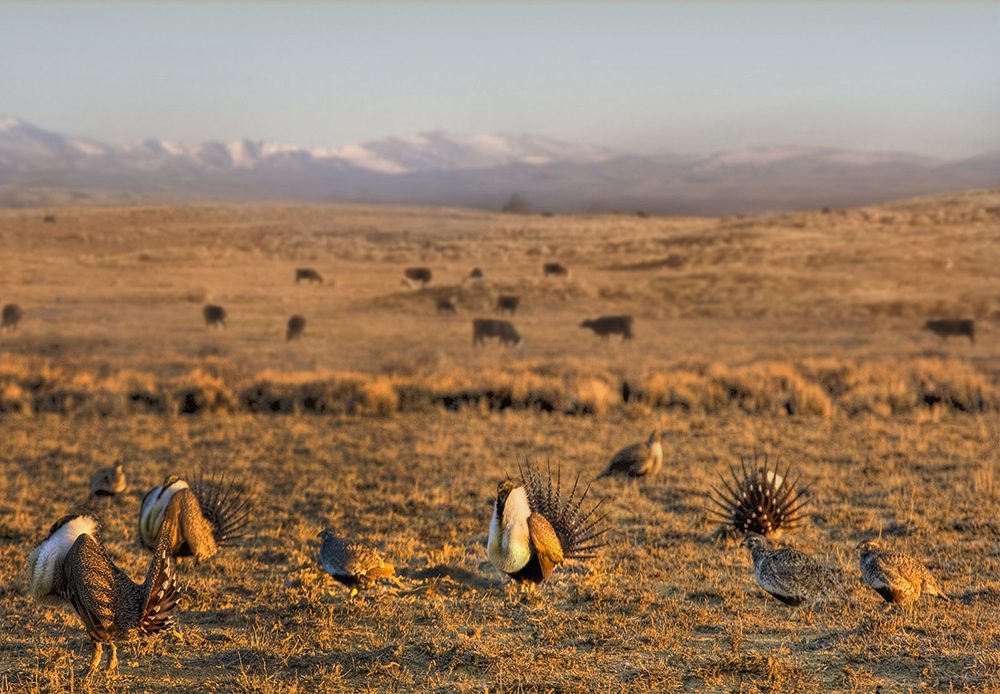When winter ends, sage-grouse return to their leks. Land Trust partners, led by volunteers like board member Angela Sitz, work together to manage their lands sustainably for future generations of people and wildlife.
In spring, the hopeful song of greater sage-grouse occurs at dawn. This iconic western species is known for distinct calls and intricate courtship displays on traditional mating grounds, called leks. In these rituals, males puff out their chests, fan their starburst tails and strut among competitors. They fill their bulbous yellow air sacs and create pops and thumps and whistles as they move their heads to intrigue nearby hens.
”They sound so cool,” recalled Angela Sitz, while reminiscing about her work completing lek counts in southeastern Oregon. “I don’t miss getting up at three a.m. and driving three hours, but I miss being out there seeing it and hearing it.” Before leaving the U.S. Fish and Wildlife Service (USFWS) in late 2019 to manage her family’s business in Sisters, Angela was a wildlife biologist for nearly 20 years. This included a decade of sage-grouse conservation with private landowners and public land managers across her homelands.

Angela played in the desert as a child in Harney County and still enjoys the wide-open spaces and the smell of sagebrush after a rain. Even from afar, she feels this habitat is undervalued. Growing up in a community of multigenerational ranchers and farmers, her role at USFWS was a great fit. She knew what was at stake for both wild and working lands and had the empathy and understanding to balance their needs.
“A lot of the same threats to the ecosystem also threaten livestock operations, including invasive annual grasses and conifer encroachment,” Angela explained. “When we have productive rangelands that are weed free, it’s good for wildlife and livestock operations. It provides cover and forage for wildlife, as well as higher quality and more reliable livestock forage. These resilient lands are less prone to catastrophic loss due to wildfire and tend to recover quicker. It’s really about a balanced, intact ecosystem that wildlife and humans can both benefit from.”
The greater sage-grouse is an umbrella species whose status is an indicator of the health of the broader sagebrush steppe ecosystem and some 350 species that live there (from lizards and voles to rabbits and pronghorn). Among other challenges, their habitat is losing native plants to invasive weeds (primarily invasive annual grasses like cheatgrass and medusahead) and increasing the risk of fire for everyone throughout the region.

A range of tools for land management
Beginning in 2011, a group was formed in Harney County to develop agreements for private landowners, primarily ranchers, to address threats to greater sage-grouse on private lands. It was part of a way to avert a potential Endangered Species Act listing of sage-grouse, and to provide assurances to enrolled landowners should they become listed.
The most controversial issue this group faced was how enrolled lands would be inventoried and what ruler USFWS would use to measure progress. These negotiations led to the creation of simple and reliable models, as well as a guide for people to manage rangelands that are threatened by annual grasses and expanding conifer trees.
The proactive threat-based models have been highly successful and include mapped project areas across more than 10 million acres in Oregon. They now guide the Bureau of Land Management (BLM) practices on more than five million acres of Oregon’s public lands and inform the state’s mitigation plan for sage-grouse habitat.
This resource has helped multiple Land Trust properties, which also benefit from Angela’s direct involvement. She joined the board in 2020 and assists in many facets, from field assessments and financial oversight, to outreach with landowners and fellow volunteers. All allow her to stay engaged in the region’s conservation efforts and she’s excited to pursue restoration projects on Land Trust acquisitions in the high desert.
BLM lands in Oregon are split into five districts. The Burns, Lakeview, and Vale Districts contain nearly 90% of the state’s greater sage-grouse and drive population trends. In 2021, the Oregon Department of Fish and Wildlife reported a 12.2% increase to an estimated 16,000 birds, following a slight increase in 2020. Despite consecutive increases, this is the third lowest estimate since 1980 observations and is currently 46% below the 2003 statewide baseline of approximately 29,000 birds.
Angela hopes this trend increases in concert with a rising interest in the high desert and an acknowledgement of the impacts of climate change. She expects more development will come, be it wind, solar or destination resorts. She also hopes that people continue coming together to share their appreciation of the land and keep parts of the desert vast and quiet enough for sage-grouse to sing their desert songs.
Cover photo by United States Department of Agriculture Natural Resources Conservation Services





